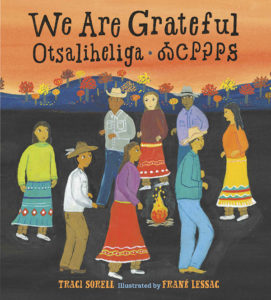We Are Grateful: Otsaliheliga
Reviewed by Phila Hoopes
December 1, 2019
 By Traci Sorell, illustrated by Frané Lessac. Charlesbridge, 2018. 32 pages. $17.99/hardcover; $9.99/eBook. Recommended for ages 3–7.
By Traci Sorell, illustrated by Frané Lessac. Charlesbridge, 2018. 32 pages. $17.99/hardcover; $9.99/eBook. Recommended for ages 3–7.
We Are Grateful: Otsaliheliga is an unexpectedly deep and moving book for young children, one that explains and demonstrates the core value of gratitude (otsaliheliga) in Cherokee culture and applies it through the seasons to traditional practices and celebrations. If that were all this large-format picture book offered in its 32 pages and colorful folk-style illustrations, it would be an engaging read. But author Traci Sorell—herself born and raised in the Cherokee Nation, and now practicing her traditions—was inspired to do more, given the lack of children’s books featuring contemporary Native Americans.
So in simple, vivid, and sensory language, Sorell has layered a rich sampling of Cherokee life and culture throughout the book: traditional foods and amusements, family roles and responsibilities, customs and crafts, and key Cherokee words. Activities of daily life demonstrate core values: not only the central value of gratitude but also the honoring of past and future generations; service to the Nation; gender equity (we see both the grandmothers and the men of the family cuddling and singing to the babies); and family roles: the elders tell stories; the men sing songs of protection, while women tend the gardens. Through example and daily practice, children learn the values of patience, compassion, and tending the land.
And they have fun! Children forage for food and wildcrafting materials for nature-based toys and musical instruments; they make moccasins and clay pots; they plant and harvest gardens; they play games. The sacred and the mundane weave together throughout all of these activities.
Simple appendices at the back of the book explain concepts in greater depth for parents and older children. There is a short explanation of the origins of Cherokee written language and a syllabary giving the sound of each syllable. Each Cherokee word introduced in the book is briefly defined and shown in English letters, phonetic syllables, and the Cherokee syllabic symbols.
“Many of us still observe the ancestral and ceremonial ways of life,” writes the author in an endnote. “We also live and work in the modern non-Cherokee world. Cherokee people are citizens of our tribal nation and of the United States. . . . We work to maintain a balance between these two worlds.” For sharing that rich, ancient, and modern world with children and parents in today’s mainstream world, I can only say, “Otsaliheliga, we are grateful.”



Comments on Friendsjournal.org may be used in the Forum of the print magazine and may be edited for length and clarity.